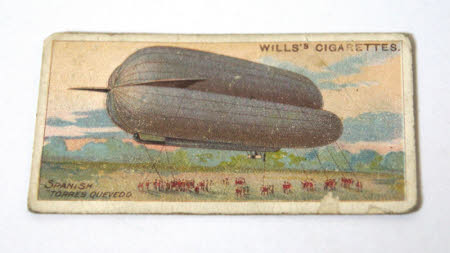Cigarette card
Wills's Cigarettes
Category
Ephemera
Date
Unknown
Materials
Card
Measurements
35 mm (Width); 67 mm (Length)
Order this imageCollection
Mr Straw's House, Nottinghamshire
NT 742586.5
Summary
One of a set of mismatched cigarette cards wrapped in a piece of newspaper. Cigarette card, the front is a full colour picture of an airship anchored to the floor by a team of men in red in a field with blue sky, with 'WILLS's CIGARETTE'. On the back printed in blue ink on a white background; 'WILLS'S CIGARETTES 17 AVIATION A SERIES OF 50 1-25 AIRSHIPS (LIGHTER THAN AIR). 26-50 AEROPLANES (HEAVIER THAN AIR). Spanish "Torres Quevedo." This curious looking craft was designed by Captain Kindelan, and an engineer whose name she bears. the reason of her peculiar shape has not been revealed, but it is the result of a number of experiments. A con- siderably larger ship of the same pattern is to be built for military purpose. W.D.&H.O.WILLS. BRISTOL&LONDON. ISSUED BY THE IMPERIAL TOBACCO Co. (OF GREAT BRITAIN & IRELAND)LTD.' Printed vertically up the sides; 'ALBUMS FOR THESE PICTURE CARDS CAN BE OBTAINED' AT 1\- EACH FROM ALL TOBACCONISTS'. Leonardo Torres y Quevedo (28 December 1852 – 18 December 1936) was a Spanish civil engineer and mathematician of the late nineteenth and early twentieth centuries. With his Telekine, Torres-Quevedo created wireless remote-control operation principles. Torres was born on 28 December 1852, on the Feast of the Holy Innocents, in Santa Cruz de Iguña, Cantabria, Spain. The family resided for the most part in Bilbao, where Leonardo's father worked as a railway engineer, although they also spent long periods in his mother's family home in the Cantabria's mountain region. In Bilbao he studied to enter an advanced high school program, and later spent two years in Paris to complete his studies. In 1870, his father was transferred, bringing his family to Madrid. The same year, Torres began his higher studies in the Official School of the Road Engineers' Corps. He temporarily suspended his studies in 1873 to volunteer for the defense of Bilbao, which had been surrounded by Carlist troops during the Third Carlist War. Returning to Madrid, he completed his studies in 1876, fourth in his graduating class. In 1902, Leonardo Torres Quevedo presented to the Science Academies of Madrid and Paris the project of a new type of dirigible that would solve the serious problem of suspending the gondola by including an internal frame of flexible cables that would give the airship rigidity by way of interior pressure. In 1905, with the help of Alfredo Kindelán, Torres directed the construction of the first Spanish dirigible in the Army Military Aerostatics Service, created in 1896 and located in Guadalajara. It was completed successfully, and the new airship, the España, made numerous test and exhibition flights. As a result, a collaboration began between Torres and the French company Astra, which managed to buy the patent with a cession of rights extended to all countries except Spain, in order to make possible the construction of the dirigible in its country. So, in 1911, the construction of dirigibles known as the Astra-Torres airships was begun. Some were acquired by the French and British armies at the beginning of 1913, and were used during the First World War for diverse tasks, principally naval protection and inspection. In 1918, Torres designed, in collaboration with the engineer Emilio Herrera Linares, a transatlantic dirigible, which was named Hispania, aiming to claim the honor of the first transatlantic flight for Spain. Owing to financial problems, the project was delayed and it was the Britons John Alcock and Arthur Brown who crossed the Atlantic without stop from Newfoundland to Ireland in a Vickers Vimy twin-engine plane, in sixteen hours and twelve minutes.
Makers and roles
Wills's Cigarettes , manufacturer


